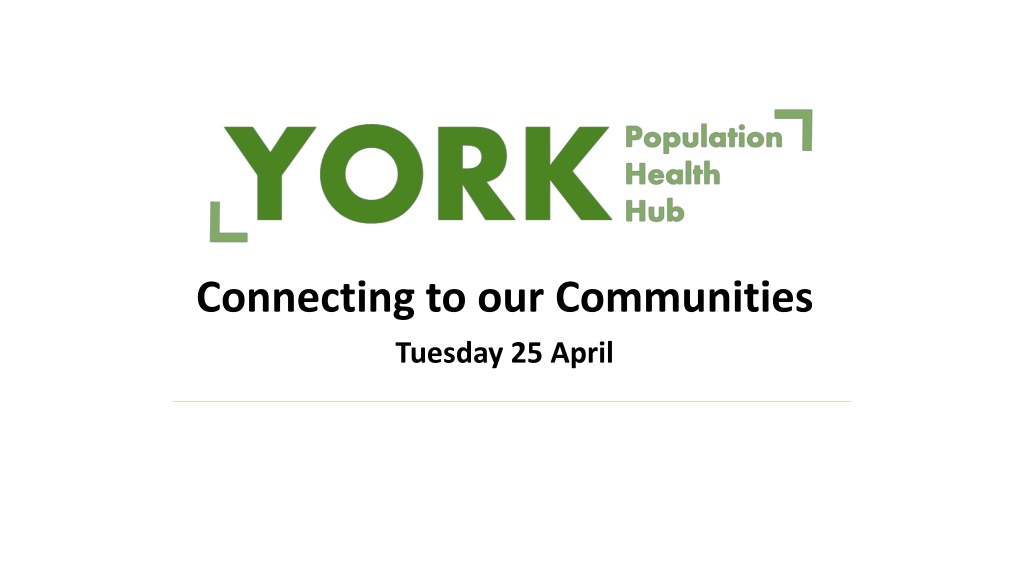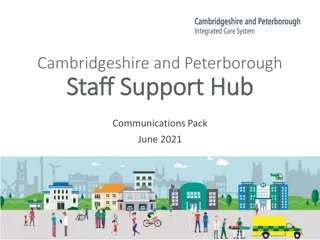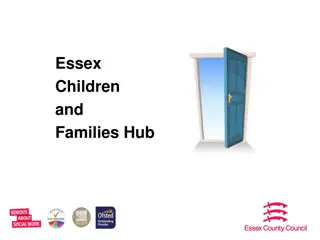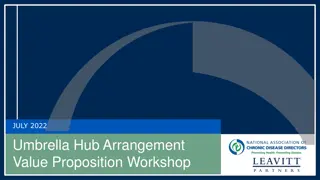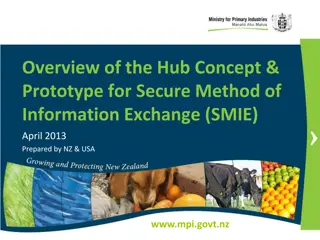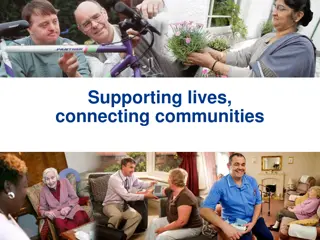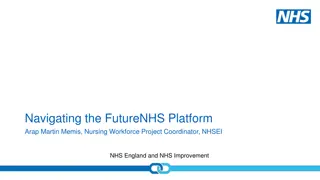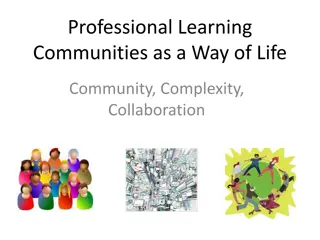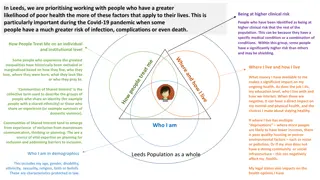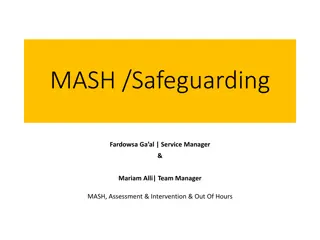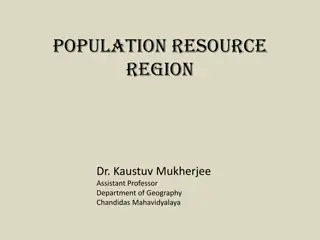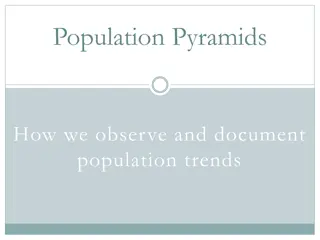Connecting to Our Communities - Population Health Hub Event
This event focuses on utilizing data to target services for better health outcomes, connecting individuals to local community support, and promoting wellbeing. It includes sessions on population health, social prescribing, data analysis tools, and addressing health inequalities in York. The agenda involves various presentations and tutorials aimed at improving health services and outcomes in the community.
Download Presentation

Please find below an Image/Link to download the presentation.
The content on the website is provided AS IS for your information and personal use only. It may not be sold, licensed, or shared on other websites without obtaining consent from the author. Download presentation by click this link. If you encounter any issues during the download, it is possible that the publisher has removed the file from their server.
E N D
Presentation Transcript
Connecting to our Communities Tuesday 25 April
Agenda 1. Welcome Peter Roderick (5 Minute) 2. Introduction to Population Health Hub (PHH) Peter Roderick (5 mins) Aims of the session: to help people to understand more about the power of data to target services to improve health outcomes to learn how CVS is connecting people to local community support to make them feel better 3. Ways to wellbeing: Christine Marmion (York CVS) (15mins) 4. Using RAIDR tool to support Proactive Social Prescribing: Peter Roderick (15 mins) 5. PHH case tutorial: Fingertips 'wider determinants' tool: Heather Baker (15 mins) 6. Questions (5 mins) Key resources: Fingertips: a large public health data collection organised into themed profiles. RAIDR tool: leading health intelligence tool that underpins approach to PHM PLEASE CAN YOU REMAIN ON MUTE UNTIL THE QUESTIONS SECTION THANK YOU
Analysing Enabling Doing JSNA core process Lunch and Learns Health Needs Assessments Early Intervention in Diabetes project Developing infrastructure (e.g. IG) Census 2021 data Metadata project PCN / Ward profiles Waiting Well project PCN capacity building Inequality Visualisation Improving Dementia Diagnosis rates (Brain health caf ) Data tool e.g. RAIDR A+E attendance small-area analysis Good practice from elsewhere (link into ICB) Proactive Social Prescribing Understanding and reducing the Health impacts of the Cost-of- Living Crisis in York PHM approach to bereavement in York LD identification ICB CYP asthma pack
Exploring health inequalities in York Understanding the picture of need through CORE20PLUS5 in York Exploring the health impacts of the cost of living crisis for York s residents Analysis of LSOA A&E attendance by age and sex, including information on the characteristics of the population by location and levels of deprivation Breakdown of the resident population of each of the five York PCNs, by ward to aid with service planning
Diabetes PHM Project PHM Proactive Social Prescribing project: to support people to live well with type 2 diabetes through an asset- based approach multi-agency approach to analyse data to identify cohort of 400 patients in York living with type 2 diabetes with risk factors for their disease progressing to further complications or other long-term conditions. Individuals were also in the bottom 50% IMD score and demonstrated minimal engagement with Primary Care in 2019/2020. Partnership Approach, working closely with CVS Social Prescribing team to: build a 'logic model' of change to support people to live well with diabetes and avoid progression into living with multiple long-term conditions. proactively reach out to the cohort, helping to build a personalised asset-based plan for their care, signposting to resources to manage their diabetes, and helping people to get the support they need to live healthy lives. Outcomes Future learning to inform service delivery Improving access to diabetes reviews accessibility communication and education Recording referral outcome to understand benefit of interventions Linking levels of clinical and social input to risk stratification Retinol screening improved recording in primary care Increased referrals to weight management programme and local/community groups and charities with follow up from social prescriber for patients Improved ONS, CSE and anxiety scores Strengthened partnership working - CYC Health Trainers and Healthwise
Social Prescribing and Population Health: An Introduction Christine Marmion Christine.marmion@yorkcvs.org.uk 25th April 2023
Social prescribing the principles Supports individuals to take greater control of their own health Person Centred Holistic Non-medical support What Matters to Me and asset-based approach Person involved in making decisions to improve their health and wellbeing A community-centred approach to health recognises the importance of the communities we live and work in, and the social networks we belong to promotes health and wellbeing reduces health inequalities in a community setting connects people to local community assets AND strengthens local community assets Health inequalities evidence that people s health and wellbeing are determined mostly by a range of social, economic and environmental factors A new approach to population health Reduce pressure on statutory services by directing people to more appropriate services and groups Helping people have more control Helping people to live well longer reducing A and E admissions and hospital stays.
Proactive Social Prescribing and Population Health VCSE partners and local clinical leaders were required to design, agree and put in place a targeted programme to proactively offer and improve access to social prescribing to an identified cohort with unmet needs. Tackling neighbourhood health inequalities - identify a population experiencing inequality in health provision
An Example: A proactive social prescribing project focussed on a cohort of people with respiratory conditions who are likely to be affected by the cost-of-living crisis Target Population: People likely to be affected by the rising cost of living People at risk of non-elective admission People with respiratory conditions Patients will be identified using an agreed, consistent clinical search across each practice . We are also exploring how we can use RAIDR to identify those that are high risk of admissions of COPD and the individuals PCN to avoid hospital admissions We will agree the inclusion and exclusion criteria for this search, based on condition, deprivation, risk of admission and contact with other services
Intervention: ALWAYS Person Centred and Asset Based What Matters to Me Holistic Approach Health Literacy Connecting and collaborating with the VCSE and Statutory Services Building Relationships A multi-agency approach Solution Focussed Adressing the Social Determinates of Health Open door policy on discharge from the service Attending groups with patients Personalised Care planning
Outcomes: Opportunity to address barriers to accessing healthcare and share learning Increased numbers of people accessing health appointments and reviews preventing an escalation in conditions Ongoing support to address social determinates of health Improved health literacy Access to ongoing support within the community which can run alongside clinical interventions More appropriate use of primary care and admissions avoidance Bert's story: Bert became known to us through an LD review but this was just the beginning of the story
Waiting Well Patient Summary RAIDR s unique to the market Waiting Well solution was developed to assist ICBs, Providers, PCNs and GP Practices to quickly identify cohorts of patients that are currently awaiting an elective procedure. Combining linked primary care and national elective waiting list data, the dashboard can enable users to target individual patients who may need support managing their long-term conditions to remain eligible for their intended procedure. In essence, to ensure patients are waiting well .
Waiting Well Waiting List Summary Tackling the elective waiting list backlog is one of the key priorities for health and social care. Utilising the Primary Care data extracted from your GP clinical systems, the dashboard risk stratifies your selected cohort of patients awaiting an elective procedure. Using a variety of filters, the dashboard provides the user with the ability to drill down based on health inequalities, treatment function group and demographics.
Waiting Well Patient Details Users with the correct access can deep dive into the data further using the expandable buttons to investigate risk factors, demographics and whether they reside in areas of deprivation based on the Index of Multiple Deprivation (IMD). Clear NHS numbers available for those RAIDR users with Patient Identifiable Data (PID) access.
Waiting Well Patient Risk Factors Users are able to move between the Patient Details and Patient Risk Factors using the toggle at the top of the chart enabling quick and effective risk stratification
Waiting Well Case Study from the NE Healthworks are an award winning charity in the North East and North Cumbria region who support patients to reduce the risk of preventable ill health while promoting equality, diversity and inclusion. The charity recently utilised RAIDR s Waiting Well dashboard to identify patients on the elective waiting list who required targeted intervention to improve their physical and mental wellbeing as well as ensuring they remained eligible for their intended treatment. John s Story Gary s Story John was referred to the Pre-op DREAMS Programme after being identified by Waiting Well as a patient with potential risk factors. Diagnosed with prostate cancer and with his diabetes unmanaged, John required support to improve his lifestyle. As a result, John s HbA1c reduced from 54 to 42 over a period of 12 weeks. His diet has significantly improved and his alcohol intake reduced. Gary was awaiting a knee operation however his unmanaged diabetes had led to regular hypos and he had sought advice on how to control his blood sugar levels. The Lifestyle team contacted Gary after he was highlighted as a potential risk utilising the dashboard. At the end of the 12 week programme, Gary reported having fewer hypos and had reduced his HbA1c from 64 to 45 as well as losing 7.5kg of body weight. The Lifestyle team also referred Gary to the PCN Pharmacist for insulin help and support. Gary has noticed an improvement in his overall fitness, reducing the need for his inhaler.
PHH Case Tutorial: Fingertips Wider Determinants Tool Heather Baker, April 2023
Outline The wider determinants of health are a diverse range of social, economic and environmental factors which influence people s mental and physical health. The link between social inequalities and health outcomes is significant- they have a major impact on health. By addressing the wider determinants of health, health equity will improve.
OHID Tool (Fingertips) Wider Determinants of Health The built and natural environment Education Employment Income Crime Communities and social capital Local Health- Small Area Public Health Data Population and demographic factors Wider determinants of health Health outcomes
If you would like more information on the different Fingertips functions please e-mail me on heather.baker@york.gov.uk
Thank you for listening. Do you have any questions?
